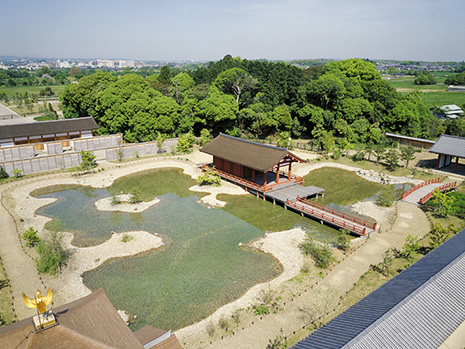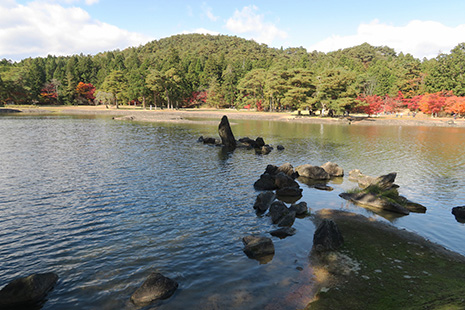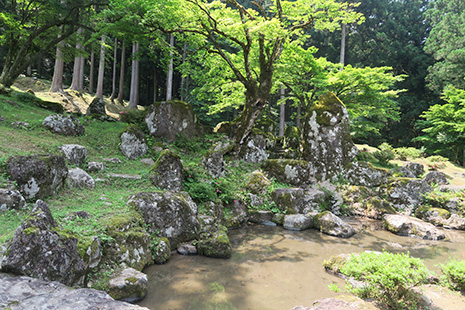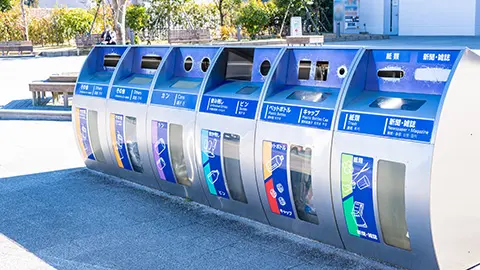VOL.195 AUGUST 2024
EXPLORE THE UNIQUE CHARM OF MANGA IN JAPAN
[Discovering Japan through the Eyes of Japanese Influencers] Traditional Gardens from Various Periods throughout Japan: Gardens in Nara, Hiraizumi, and Fukui

Photo: Nara National Research Institute for Cultural Properties

ONO Kenkichi is a professor at Osaka University of Tourism, specializing in garden history and cultural heritage preservation. In this month’s issue, he explains traditional gardens from the 8th, 12th, and 16th centuries in different parts of Japan.
Many people think of Kinkakuji Temple or Ryoanji Temple in Kyoto when they think of traditional Japanese gardens. In fact, Japan has many gardens from different historical periods preserved all over the country, which is rare even on a global scale. Here, I would like to introduce 8th-century gardens in Nara, 12th-century gardens in Hiraizumi, and 16th-century gardens in Fukui.
The design of the traditional Japanese garden as we know it today was born in the 8th century in then capital Heijo-kyo (present-day Nara City and Yamatokoriyama City, Nara Prefecture). While being influenced by the gardens of the Tang Dynasty of China, gardens were created based on natural landscape motifs in accordance with the climate and topographical features of Japan. Today there are two gardens from this period that have been excavated and restored through archaeological research and are open to the public. Toin Garden (Eastern Palace Garden) at Heijo-kyu (Nara Palace) was used as a venue for imperial banquets. The garden features buildings and bridges arranged around the pond which is an intricate shape by a series of jutting like peninsulas and recesses like inlets. On the northern shore of the pond is an authentic stone arrangement dating back to the 8th century. The Garden at Block 6, East Second Ward on Third Street of Heijo-kyo capital site was also an official facility for banquets. The highlights of this garden are the long, meandering pond in the shape of a dragon and the stone arrangements on its banks. The entire pond including stone arrangements, from the bottom covering to the banks, are original and dating back to the 8th century. These two gardens, both constructed nearly 1,300 years ago, are rare examples around the world and a must-see for anyone interested in gardens.

Photo: ONO Kenkichi
After Kyoto became the capital of Japan in the late 8th century, it rose to prominence as the center of a distinctive garden culture in which gardens were built as part of Buddhist temples. Under the influence of this culture, magnificent Buddhist temple gardens were created in Hiraizumi (now Hiraizumi Town, Iwate Prefecture), which was the stronghold of the Oshu Fujiwara clan that ruled the present-day Tohoku region in the 12th century. The garden of Motsuji Temple has been well preserved in its original appearance from that time. On the south side of the now-lost main hall is the Oizumi-ga-ike pond, which stretches 200 meters from east to west with an island in the center. Of particular interest are the spot likened to a cape and the single standing stone rising above the surface of the water in the southeastern part of the pond, the stone arrangement on the tsukiyama artificial hill in the southwestern part, and the yarimizu stream that was excavated and restored in the northeastern part. All of these structures were built in the 12th century and remain largely intact. The beauty of the garden is especially striking during the seasons of lush young leaves and colorful fall foliage. I would also like to recommend the garden of the nearby Kanjizaioin Temple Site and the recently restored garden of the Muryokoin Temple Site.

Photo: ONO Kenkichi
The late 15th and 16th centuries were a time of civil war in Japan. During this period, the warlords who held military control over their respective provinces also paid special attention to maintaining their cultural power and created unique gardens in their residences and castles. Ichijodani (present-day Fukui City) was the stronghold of Asakura, a warrior clan that ruled Echizen Province (part of present-day Fukui Prefecture) for about 100 years, and its ruins are generally well preserved. The garden excavated at the site of Asakura Yakata (Residence) is small in area, but has a sophisticated design with an arrangement of rocks that resembles a waterfall. The Suwa Yakata (Residence) Site Garden and the Yudono Site Garden, both characterized by arrangements of massive rocks projecting power, also demonstrate the Asakura clan’s taste in gardens. A short trip on a scenic route through a delightful rural landscape by local train from Fukui Station, which is also a stop on the Hokuriku Shinkansen Line, will take you to the ruins and gardens of Ichijodani to discover a Japan you never knew existed.

Photo: ONO Kenkichi
ONO Kenkichi
Professor at Osaka University of Tourism. Honorary fellow at Nara National Research Institute for Cultural Properties. Doctor of Agriculture (Kyoto University). Author of Iwanami Nihon Teien Jiten (“Iwanami Japanese Garden Dictionary”) (Iwanami Shoten, Publishers, 2004), Nihon Teien – Kukan no Bi no Rekishi (“Japanese Gardens: History of the Beauty of Space”) (Iwanami Shinsho / Iwanami Shoten, Publishers, 2009), Nihon Teien no Rekishi to Bunka (“History and Culture of Japanese Gardens”) (Yoshikawa Kobunkan, 2015), etc. Gives lectures on Japanese gardens and tourism all over the country.![]()
By ONO Kenkichi
Photo: ONO Kenkichi; Nara National Research Institute for Cultural Properties

